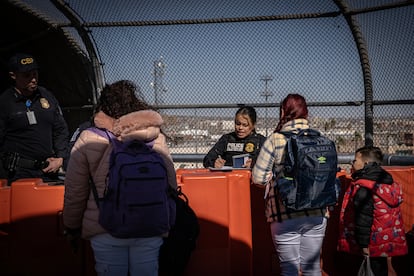Data | Who are the more than 11 million migrants Trump plans to deport?
Less than 4% of undocumented immigrants have a criminal record, and almost eight out of 10 have been in the United States for more than five years

One in four foreigners in the United States is an undocumented migrant. At least 11 million people reside in the country without legal status, with 77% having lived there for five years or more, according to data from the 2022 census. In 1980, 80% of undocumented migrants were concentrated in six states — California, Texas, Florida, New York, New Jersey, and Illinois. Today, their distribution is broader, with these six states now accounting for 56% of the total.
Accurately counting all undocumented immigrants in the United States is a challenging task. However, the government can track those who pay taxes, as it is mandatory regardless of immigration status. What’s more, independent organizations estimate there could be as many as 14 million undocumented migrants in the country.
Approximately six million people hold temporary residence permits in the U.S. Of these, around 2.6 million are awaiting decisions on their political asylum requests, primarily from Latin American countries. Another 300,000 have been provisionally accepted as refugees, including Ukrainians and Afghans. Additionally, 540,000 individuals are beneficiaries of DACA, a program introduced by Barack Obama to regularize the status of young people who arrived as minors.
Forty percent of undocumented immigrants in the U.S. are from Mexico. However, over the last decade, migration from Mexico has decreased. In contrast, the number of Venezuelan migrants has increased fourfold, and the number of Colombians has nearly doubled.
Since returning to the White House on Monday, Trump has made it clear that he wants to deport as many undocumented immigrants as possible. He will start, he said, with migrants with criminal records. According to the U.S. judicial system, there are at least 425,431 immigrants classified as criminals, though many of the offenses are minor infractions.
In 2024, 22% of the charges were for “traffic violations,” which include driving with a broken headlight, driving without a license and ignoring a traffic sign. Undocumented migrants are often unable to obtain driver’s licenses in most states due to their lack of legal documentation.
Immigration-related offenses were the second most common category, accounting for 18% of all charges. These include entering the country illegally, re-entering after deportation, or providing false information upon entry. Theft of various kinds made up 7% of the offenses, while drug-related crimes accounted for 6%.
In recent years, migrants with criminal records have accounted for less than half of those deported.
A long history of mass deportations
The latest figures from Immigration and Customs Enforcement (ICE) reveal that the U.S. has been carrying out mass deportations for years. In 2024 alone, under the Biden administration, 271,484 people were deported — more than in any single year of Donald Trump’s previous term.
Deportations under both the Biden and Obama administrations were concentrated primarily at the southern border, with most cases involving pushbacks following detected illegal crossings. The highest number of deportations in recent history occurred during Obama’s presidency in 2012, when more than 400,000 people were deported; 80% of these deportations involved individuals crossing between the United States and Mexico.
What sets Trump apart is his refusal to focus solely on new arrivals at the border. Instead, he has threatened mass raids on homes and workplaces in major cities far from the border, targeting migrants who have lived in the U.S. for years.
Trump’s proposed arrests threaten to violate the “sanctuary city” policies of places like New York, Chicago, and Los Angeles — major urban centers that have chosen not to cooperate with ICE and have implemented less restrictive measures toward undocumented immigrants. Despite this, Trump’s team has announced plans to sign an executive order granting ICE the authority to operate in these cities.
In sanctuary cities, undocumented migrants can often obtain a state-issued ID, which grants access to banking, healthcare, and educational services. In some cases, they can even acquire a driver’s license, though this is permitted in only 18 of the 50 states.
Currently, undocumented immigrants have limited pathways to regularize their status. One of the most common routes involves children born in the U.S. to undocumented parents. These children, who automatically gain U.S. citizenship by birth, can petition for their parents’ legal status when they turn 21. However, Trump has indicated his intent to abolish birthright citizenship, even though it is a right enshrined in the Constitution.
Even under current law, the process of regularization is fraught with challenges. Applicants must meet stringent criteria, such as having no traffic violations or administrative infractions and proving they have paid taxes consistently. According to Pew Research, 4.4 million children in the U.S. have at least one undocumented parent.
Asylum appointments cancelled
Trump has announced plans to end the CBP One cell phone application, a tool that allowed individuals to request political asylum and provided a safer alternative to crossing the border into the United States. Introduced by the Biden administration, the app was designed to keep migrants on the Mexican side of the border while they awaited appointments with U.S. immigration authorities. It also helped expedite the rejection of applications deemed ineligible.
According to The New York Times, Trump’s announcement has already led to the app’s closure as of Monday, resulting in the cancellation of appointments for approximately 30,000 migrants.
In 2023, a total of 456,750 asylum applications were registered at U.S. entry points, with nearly half filed by Cubans and Venezuelans. During Trump’s first term (2017–2021), despite his hard-line rhetoric, more asylum applications were approved than under the Democratic administrations of Obama and Biden.
The asylum system faced significant disruption during the Covid-19 pandemic due to the implementation of Title 42. This policy allowed migrants who crossed the border illegally to be immediately expelled without the opportunity to request asylum. Although Title 42 was introduced under Trump, the Biden administration oversaw the return of the majority of the three million individuals affected by the policy. The CBP One cell phone app was introduced in 2023, following the end of Title 42.
Sign up for our weekly newsletter to get more English-language news coverage from EL PAÍS USA Edition
Tu suscripción se está usando en otro dispositivo
¿Quieres añadir otro usuario a tu suscripción?
Si continúas leyendo en este dispositivo, no se podrá leer en el otro.
FlechaTu suscripción se está usando en otro dispositivo y solo puedes acceder a EL PAÍS desde un dispositivo a la vez.
Si quieres compartir tu cuenta, cambia tu suscripción a la modalidad Premium, así podrás añadir otro usuario. Cada uno accederá con su propia cuenta de email, lo que os permitirá personalizar vuestra experiencia en EL PAÍS.
¿Tienes una suscripción de empresa? Accede aquí para contratar más cuentas.
En el caso de no saber quién está usando tu cuenta, te recomendamos cambiar tu contraseña aquí.
Si decides continuar compartiendo tu cuenta, este mensaje se mostrará en tu dispositivo y en el de la otra persona que está usando tu cuenta de forma indefinida, afectando a tu experiencia de lectura. Puedes consultar aquí los términos y condiciones de la suscripción digital.
More information
Archived In
Últimas noticias
Most viewed
- Reinhard Genzel, Nobel laureate in physics: ‘One-minute videos will never give you the truth’
- Oona Chaplin: ‘I told James Cameron that I was living in a treehouse and starting a permaculture project with a friend’
- Pablo Escobar’s hippos: A serious environmental problem, 40 years on
- Why we lost the habit of sleeping in two segments and how that changed our sense of time
- The fall of a prolific science journal exposes the billion-dollar profits of scientific publishing











































